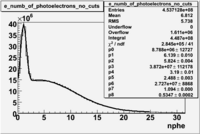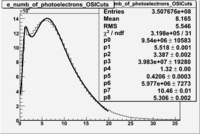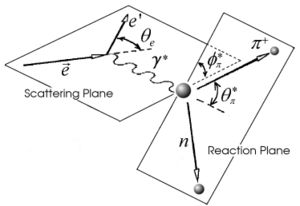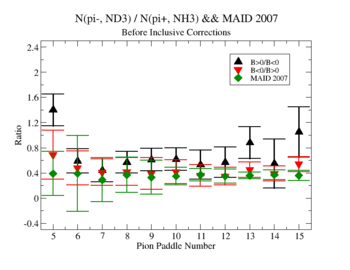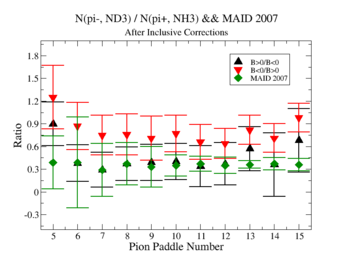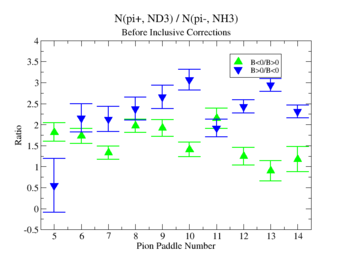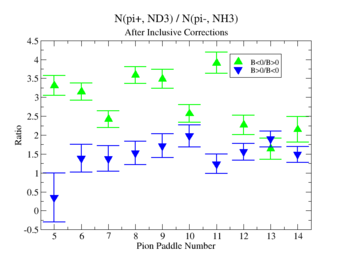Tamar Electron and Pion Efficiency
Electron-Pion separation
The requirements of the measured particles attributes that are used to differentiate electrons from negative pions is described below. Separating a negatively charged pion from an electron becomes more difficult when a negative pion has sufficient energy to generate cerenkov radiation and as a result may be misidentified as an electron. This contamination of the electron sample is reduced using cuts on the energy deposited in the electromagnetic calorimeter and the number of photoelectrons in the Cherenkov counter.
The energy deposited in the calorimeter for electrons and pions is different. Pions are minimum ionizing charged particles when their momentum is above ~ 0.8 GeV and therefore the energy they deposit in the calorimeter is momentum independent. On the other hand, electrons produce photoelectrons and generate an electromagnetic shower releasing energy into the calorimeter that is proportional to their momentum. The following cut is introduced to take advantage of this feature: . The cut was also applied to the energy collected in the inner part of the calorimeter: , because the ratio of the total energy deposited to the energy deposited in the inner calorimeter depends on the thickness of the detector and is a constant.
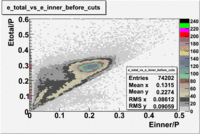
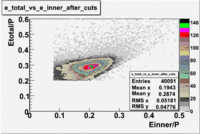
Figure 1.1. The energy deposition into the total and inner calorimeter before and after cuts.
In addition to the cut on the energy deposited into the electromagnetic calorimeter, misidentified electrons are reduced by requiring a signal in the threshold CLAS Cherenkov detector. Pion's misidentified as electrons have been shown to produce around ~1.5 photoelectons (PEs) in the Cherenkov detector, as shown below. Geometrical cuts on the location of the particle at the entrance to the Cerenkov detector were applied to reduce the pion contamination. The second histogram below shows that, after these cuts, the peak around 1.5 PEs is substantially reduced.
| No cuts | OSI Cuts |
Figure 1.2. The number of photoelectrons before and after cuts.
Exclusive Pi+ production using NH3
A comparison was made with the results from experiment E99-107 <ref name="Park2008" >Park, K., Burkert, V. D., & Kim, W. (The CLAS Collaboration) Phys. Rev., C77, 015208.</ref> as one benchmark to evaluate the integrity of this semi-inclusive analysis. Experiment E99-107 measured exclusive pion production (->) using a liquid hydrogen target and the CLAS. The EG1 experiment performed similar measurements using a polarized NH3 target allowing for an asymmetry measurement in addition to the differential cross-section in the nucleon resonance region for . In the EG1 experiment polarized target and a 5.7 GeV continuous electron beam resulted in a luminosity of .
The kinematics of single pion electroproduction can be described by five variables: the virtual photon negative four-momentum transfered squared , W invariant mass of the photon-nucleon system, the polar and the azimuthal angle of the outgoing pion in center of mass frame and the scattered electron azimuthal angle.
The five-fold differential cross section can be written in the following way for a single pion electroproduction:
where - the integrated luminosity, is the acceptance factor, represents the efficiency of the cherenkov detector and the Jacobian term can be expressed in terms of the initial and final energy of lepton:
Because of wide range of kinematics, was measured only for certain lepton scattering angles and invariant mass (W). Applying above described cuts: EC_inner>0.06, EC_tot/p>0.2, nphe>2.5 and , for the following invariant mass and the vs relative rate distribution is shown below on the graph and compared with E99-107 data, which by itself is in agreement with the models.
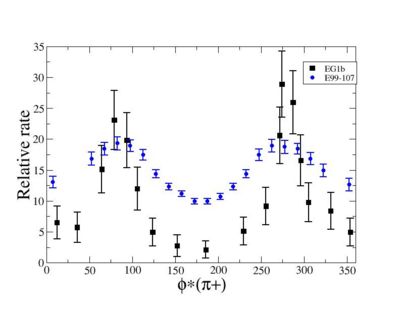 Figure 2.2. vs Relative rate for fixed and <ref name="Park2008" > Bogus text</ref> <ref> http://clasweb.jlab.org/cgi-bin/clasdb/msm.cgi?eid=14&mid=16&data=on </ref> |
The EG1b data for kinematics chosen above show the same shape as E99-107 data.
Inclusive and Exclusive Efficiencies
The goal of this thesis is to measure the semi-inclusive asymmetry when an electron and a pion are detected in the final state. Pions of opposite charge will be observed using the same scintillator by flipping the CLAS Torus magnetic field direction. Although the pions will be detected by the same detector elements, the electrons will intersect different detector elements. As a result, the electron efficiency will need to be evaluated in terms of the electron rate observed in two different scintillator paddles detecting the same electron kinematics. Pairs of scintillator paddles with the highest semi-inclusive rate.
The electron efficiency of individual scintillator detectors using the 4.2 GeV data for ND3 and NH3 targets is investigated below. Only the electron is detection in the final state (inclusive case). The pion contamination in the electron sample was removed by the applying cuts described above. The electron paddle number 10 (B<0) and 5 (B>0) were chosen respectively because they contained the most electron events in a first pass semi-inclusive pion analysis of the data set. The electron kinematics(Momentum, scattering angle and invariant mass) for these scintillators is shown on Fig. 3.1.
FC is not a unit, you need to use the calibration to convert FC counts to nC
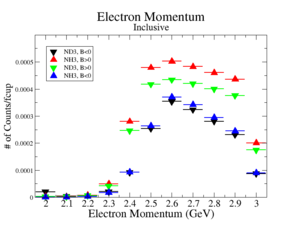 |
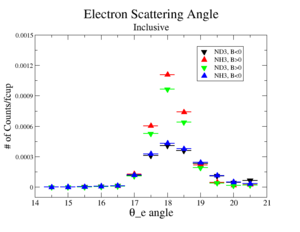 |
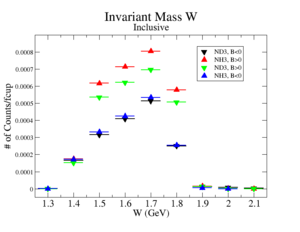
|
| Electron Momentum((NH3,B>0), (NH3,B<0), (ND3,B>0) && (ND3,B<0)) | Electron Scattering Angle ((NH3,B>0), (NH3,B<0), (ND3,B>0) && (ND3,B<0)) | W Invariant mass((NH3,B>0), (NH3,B<0), (ND3,B>0) && (ND3,B<0)) |
Figure 3.1. Electron Kinematics(The histograms presented above are not normalized by faraday cup. We just want to show the kinematic range for chosen electron events).
Ratios of the inclusive electron rate, normalized using the FC, of scintillator paddles 5 and 10 were measured. The two ratios are designed to measure the CLAS detectors ability to observed the same electron kinematics using different detector elements positioned for opposite Torus polarities.
Notice the ratio is statistically the same if the NH3 and ND3 targets are used for this ratio in a manner which will be similar to the semi-inclusive analysis.
The above ratios, which have been observed to be ammonia target independent, indicate a difference in electron detector efficiency when the Torus polarity is flipped. In order to make detector efficiency the same for electrons, the ratios were used as a "correction coefficient". The "correction coefficient" for the case is and for the it is .
The measured single pion electroproduction rate was compared to the MAID 2007 unitary model that has been developed using the world data of pion photo and electro-production to determine the impact of using the above "correction coefficient". The model is well adopted for predictions of the observables for pion production, like five fold cross section, total cross secton and etc.
The MAID 2007 model has predictions of the total cross section for the following two cases, that are related to our work:
- + proton + neutron
- + proton + neutron
- + neutron + proton
- + neutron + proton
The ratio of the pions detected in the scintillator paddles, located between the Cherenkov counter and electromagnetic calorimeter, is shown on Fig. 3.2. The ratios were taken for four different cases. Assuming that, for the inbending case positive pions and for the outbending case negative pions have the same trajectories(the same kinematics) and vice versa((the inbending,negative pion) and (the outbending, positive pions)).
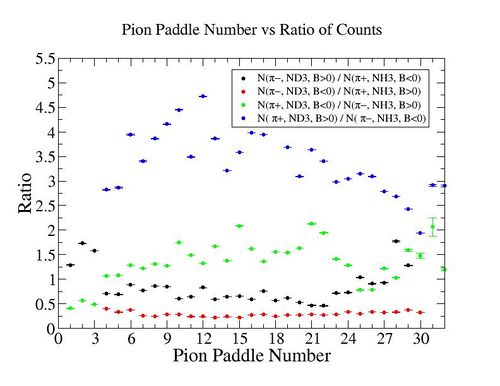
Figure 3.2. Pion paddle number vs Ratio.
Using MAID 2007 total cross section was calculated for the following invariant mass and four momentum transferred square: and . <ref name="MAID2007" > http://wwwkph.kph.uni-mainz.de/MAID//maid2007/maid2007.html</ref>. After applying correction coefficients from inclusive cases, the ratios have been compared to the results from MAID2007.
After applying correction coefficients from inclusive cases, the ratios have been compared to the results from MAID2007.
Figure 3.3. Pion paddle number vs Ratio before and after correction.
Applied corrections are following:
Notes
<references/>
Media:NH3positivepionMAID.pdfMedia:ND3negativepionMAID.pdf
Nomenclature
- ) - Number of events in which and electron are detected in the final state using target, when .
- ) - Number of events in which and electron are detected in the final state using target, when .
- ) - Number of events in which and electron are detected in the final state using target, when .
- ) - Number of events in which and electron are detected in the final state using target, when .
- ) - Number of events in which and electron are detected in the final state using target, when .
- ) - Number of events in which and electron are detected in the final state using target, when .
- ) - Number of events in which and electron are detected in the final state using target, when .
- ) - Number of events in which and electron are detected in the final state using target, when .
